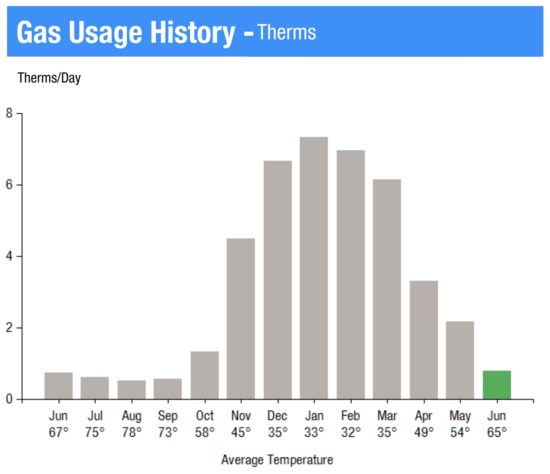Rough Utility Costs |
July 20th, 2019 |
| house, money |
First, the inputs (yours are probably different):
Water cost: $17.31/HCF ($0.023/gal)
Gas cost: $1.32/therm
Electricity cost: $7 + $0.21/kWh
What does hot water cost? Our water is heated by our furnace, which is a high-efficiency gas burner, rated at 96% efficient. A therm is 100k BTU, and heating a pound of water by 1F takes 1 BTU, there are 8.34 pounds per gallon of water, our water enters the house at about 60F, and we heat the water to about 130F. So, to turn a gallon of cold water into a gallon of hot water we need to heat it 70F, which requires 584 BTU. That's 0.0058 therms, but the boiler has 4% losses, so 0.0061. Then figure we lose 10% for water sitting in pipes, but during heating season that doesn't matter, and heating season is half the year, so 5% loss, which brings us to 0.0064 therms. At $1.32/therm that's $0.008/gal.
This means that hot water is 35% more expensive than cold water:
Cold water: $0.023/gal
Hot water: $0.031/gal
What would a shower be? Let's say you shower for ten minutes, and the shower head is an efficient 2.0gal/min. Then we have:
Cold shower: $0.46
Warm shower: $0.54
Full hot shower: $0.62
What about lights and fans? A modern 60-watt equivalent LED or CFL is about 10W, while a fan is more like 75W. Running one for a full 24hr is then:
Light: $0.05/day
Fan: $0.38/day
While we don't have AC [1], they run about 1W per 10BTU. A house our size might need 60k BTU, so 6kW at peak output:
Whole house AC on full: $30/day
Whole house AC on 1/3: $10/day
Single window AC on full: $3/day
I'd love to include something here for the cost of heating, per degree, so we can make a reasonable decision about (say) 66F vs 68F. Unfortunately this is pretty hard to figure without either good estimates of how our building works or some sort of test. You can get a very rough estimate, though, by looking at how much gas was burned and how far the average temperature was from the target house temperature. Here's a graph from our gas company:
Gas covers hot water and heating only, no cooking, and since summer months show ~0.5 therms/day that's probably hot water. For heating, assuming we were averaging 62F inside the house, I get:
| month | temp | deficiency | therms/day | heating therms/day | therms/F |
| Oct | 58F | 4F | 1.4 | 0.9 | 0.64 |
| Nov | 45F | 17F | 4.5 | 4.0 | 0.89 |
| Dec | 35F | 27F | 6.7 | 6.2 | 0.93 |
| Jan | 33F | 29F | 7.4 | 6.9 | 0.93 |
| Feb | 32F | 30F | 7.0 | 6.5 | 0.93 |
| Mar | 35F | 27F | 6.2 | 5.7 | 0.92 |
| Apr | 49F | 13F | 3.3 | 2.8 | 0.85 |
| May | 54F | 8F | 2.2 | 1.7 | 0.77 |
It looks like figuring 0.93 therms/day/F for the core winter months is pretty close. At $1.34/therm that's $1.23/day/F.
I don't think any of these numbers are large enough to substantially change what we do, but it's nice to have a better sense of how much things cost.
[1] With this heat wave we may change our minds, though.
- Air Conditioning
- Estimating the ROI of Insulation
- Wireless Outlet Switching
- Electric Kettle vs Stove
- Lemonade Stand Costs?
Comment via: facebook, substack
